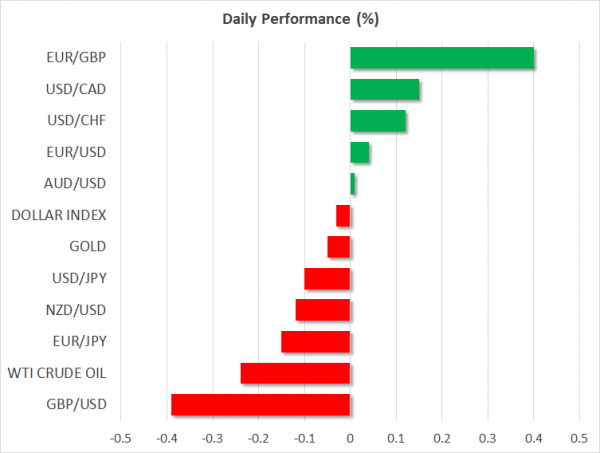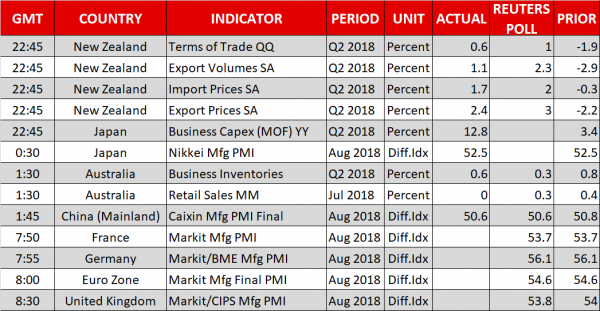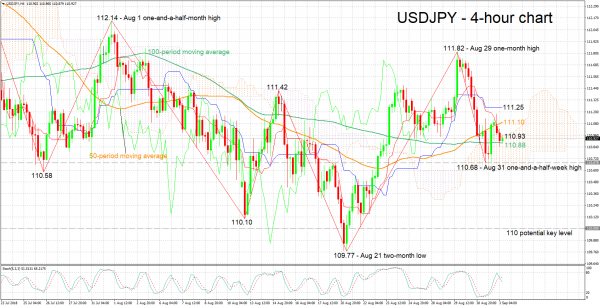Here are the latest developments in global markets:
FOREX: The dollar was nearly flat against a basket of six major currencies on Monday (-0.03%), after posting considerable gains in the previous session. Meanwhile, the British pound opened with a negative gap following some not-so-encouraging Brexit signals over the weekend from both the EU and the UK.
STOCKS: Wall Street closed mixed on Friday, as trade negotiations between the US and Canada ended without an accord. The S&P 500 was practically flat (+0.01%), the Dow Jones pulled back slightly (-0.09%), while the Nasdaq Composite edged higher (+0.26%) – flirting with its record highs. US markets will remain closed today in celebration of the Labor Day holiday. Meanwhile, Asia was a sea of red on Monday, with sentiment appearing fragile amid concerns the US-China trade standoff may escalate further this week. In Japan, the Nikkei 225 and the Topix fell by 0.69% and 0.87% respectively, while in Hong Kong, the Hang Seng dropped by 0.80%. In Europe, futures tracking the major indices were mixed, though most were close to neutral territory. The exception was the UK’s FTSE 100, which was set to open higher amid a drop in the pound.
COMMODITIES: Oil prices were mixed on Monday. While WTI was lower by 0.24% at $69.67 per barrel, Brent was up by 0.17%, trading at $77.80/barrel. Both benchmarks ended lower on Friday, albeit only modestly so. The Baker Hughes oil rig count showed its first increase in three weeks on Friday, bringing back to the forefront the narrative that US production is increasing. Meanwhile, worries around the impact of a potential US-China trade war continued to cloud the outlook for oil demand. In precious metals, gold prices were little changed on Monday, trading marginally above the $1,200 per troy ounce handle.
Major movers: Sterling gaps lower on Brexit worries; dollar bounces
The British pound opened with a gap lower this week amid renewed Brexit worries, following some remarks over the weekend from EU chief negotiator Michel Barnier, as well as UK PM Theresa May. Barnier, who was responsible for the pound’s surge last week after he said the EU is willing to provide the UK with a special deal, toughened his rhetoric – indicating on Sunday that he is ‘strongly opposed” to May’s proposals on trade. Separately, writing in the Telegraph, PM May ruled out the prospect of a second Brexit referendum.
To be fair, this was hardly a surprise, as she has repeatedly rejected such calls in the past. Still, combined with Barnier’s apparent reversal and the continued lack of progress in the talks, it was enough to dispel some optimism and push sterling lower. The road for the pound will probably remain bumpy as the negotiations enter their final stretch in the coming weeks, with any sustained rallies appearing unlikely until – and if – a deal is seen as being near its completion.
Meanwhile, the dollar edged up on Friday, without any clear catalyst behind the move. Instead, the currency’s gains appear to have been driven by month-end flows as the European trading session was drawing to a close. Elsewhere, NAFTA talks between the US and Canada ended without an agreement on Friday, sending the loonie lower. Talks will resume on Wednesday, with the loonie’s short-term direction likely to hang in the balance.
Staying on trade, the US-China standoff seems set to heat up again later this week. The Trump administration may proceed with imposing tariffs on $200bn worth of Chinese goods it has threatened as early as on Thursday, potentially escalating the situation further. China has previously said it would retaliate to such a move, and if so, risk appetite may take a hit, leading investors to divert funds away from ‘risky” assets and into safer ones, such as the Japanese yen.
Day ahead: Eurozone and UK on receiving end of manufacturing PMI numbers; trade remains in focus
Monday’s calendar is relatively light, with US markets being closed for Labor Day. Among the few data points are manufacturing PMI figures out of the eurozone and the UK. Most attention though, is expected to remain on issues such as trade rather than on any releases.
The eurozone’s final manufacturing PMI print for August is due at 0800 GMT, with the reading anticipated to be confirmed at 54.6, its lowest since November 2016; trade fears are partially to blame for the fall in the measure. Germany and France, the eurozone’s two largest economies, will see the release of their respective manufacturing PMI numbers at 0755 GMT and 0750 GMT correspondingly.
At 0830 GMT, the UK’s manufacturing PMI for August will be hitting the markets. The gauge is projected to ease to 53.8 from July’s 54.0. If expectations materialize, this would be the lowest since late 2016; the index touched the same multi-month low level in April this year. Unlike the eurozone, the UK sees only one and final PMI release, something which might render the British currency more sensitive to the data. Lastly, the nation’s PMI figures for construction and the all-important services sector are due on Tuesday and Wednesday respectively.
Meanwhile, trade remains a dominant theme in markets, with the odds for further escalation in Sino-US relationships on the front being on the rise, especially after last week’s comments by President Trump signaling readiness to push forward with additional tariffs as soon as the current week. Additionally, last week’s discussions between Canada and the US on forging a new North American trade pact weren’t fruitful. As a result, Trump notified Congress that he intends to proceed with a bilateral deal with Mexico.
Brexit also looms large in the background, with sterling expected to be sensitive on any updates and commentary on the issue.
Chicago Fed President Charles Evans – a non-voting FOMC member in 2018 – will be participating in a panel discussion before the Central Bank of Argentina’s ‘Dealing with Monetary Policy Normalization” Money and Banking Conference at 1830 GMT.
Technical Analysis: USDJPY looking bearish in short-term with negative momentum easing
USDJPY is trading roughly 90 pips below last week’s one-month high of 111.82. The Tenkan-sen and Kijun-sen lines are negatively aligned in support of a bearish short-term picture. Notice though that the Kijun-sen has flatlined, the implication being that negative momentum is weakening. The stochastics, however, are giving a bearish signal in the very short-term as the %K line has moved below the slow %D one.
Rising trade tensions are likely to divert funds to the safe-haven perceived yen, pushing USDJPY lower. Given a move below the 100-period moving average at 110.88, support to declines may come around Friday’s one-and-a-half-week low of 110.68, including the Ichimoku cloud bottom at 110.62. Further below, the 110 round figure would increasingly come into scope.
Conversely, easing trade fears may push the pair higher. Immediate resistance seems to be taking place around the current level of the Tenkan-sen at 110.93 and the Ichimoku cloud top at 110.97. Not far above lies the 50-period MA at 111.10 and the Kijun-sen at 111.25. Steeper gains would turn the attention to the zone around the one-month high of 111.82 from last week, including the 112 handle.
















